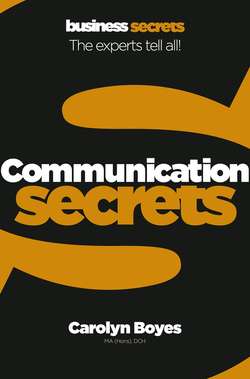Читать книгу Communication - Carolyn Boyes - Страница 11
1.6 Choose your words
ОглавлениеThere is another key difference between people that’s worth paying attention to. It is what’s sometimes called the preferred language type. In everyday language, we often use words associated with the senses: seeing, hearing and feeling. This relates to how we process information. If you communicate according to the preferred choice of the listener, they will be more open to what you say.
People who use a lot of words associated with seeing understand better if you use similar words back to them, and it’s the same for other senses, such as hearing and feeling.
Visual. Here are some examples of the kinds of phrases you can use when communicating with a visually inclined person: “Appears to me”, “Get a perspective on”, “In view of”, “Eye to eye”, “Hazy idea”, “Dim view”, “In light of”, “Mental image”, “Paint a picture”, “Looks like”, “Short sighted”, “Pretty as a picture”.
Auditory. Other people use words associated with hearing and sound. Use these types of phrases to make them feel ‘in tune’: “Clearly expressed”, “Earful”, “Loud and clear”, “Tongue-tied”, “Power
“The most basic of all human needs is the need to understand and be understood. The best way to understand people is to listen to them”
Ralph Nichols, business coach
of speech”, “Rings a bell”, “Clear as a bell”, “To tell the truth”, “Outspoken”, “Tuned in/out”, “Voiced an opinion”.
Kinaesthetic. Finally, some people prefer words associated with feeling, known as the kinaesthetic sense: “Come to grips with”, “Firm foundations”, “Cool, calm and collected”, “Get a handle on”, “Get the drift of”, “Get in touch with”, “Grapple with”, “Fight your corner”.
It may take you a while to get to grips with this concept, but if you tune in to the different ways in which different people speak, you will begin to notice that they use varying amounts of sense-specific words. Once you have become attuned to how other people speak, you can adapt your own language accordingly. This will build your ability to be a highly flexible communicator. You can also practise by reading. Notice how different writers are more visual, auditory or kinaesthetic in the way that they write.
The sense someone chooses corresponds to how they process thoughts so this is a very vital piece of communication to observe.
Pick your words carefully according to who you are communicating with.
